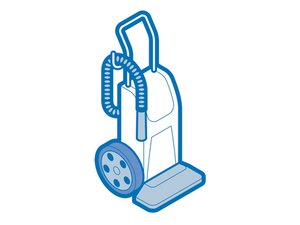The Basics
Before starting this procedure make sure all tanks or buckets in the unit are empty.
For some of the checks, you will want to have the unit plugged in and be able to turn it on, so be sure to have a power outlet nearby for testing.
Prop the machine up with a small piece of wood, so the suction nozzle is off the floor; this will help with the first check. Make sure the machine is stable and won't tip over.
Next, disconnect the hose cuff assembly at the rear of the machine and turn the machine on.
- Check to see if there is suction at the tapered fitting (the upper fitting) that runs to the dome on the front of the machine (toward the motor). You don't need to use the vacuum tester at this point.
- If you get good suction here, the problem is probably in the path from the nozzle.
- If the suction is poor, you may have a clog or leak downstream of this point toward the motor. A good starting check is the filter inside the dome. Go to Clogged Filter for the next step. If the suction is good, do the next item here.
- With the machine running, and the nozzle off the floor, insert the tapered piece into the hose cuff, and note if the motor sound changes.
- If there is little change, then there could be a cracked or detached hose inside the unit.
- If the sound changes like the motor speeds up, there is likely a clog from the nozzle to this point. Go to the next step.
Causes
The first place to check is the nozzle at the front edge of the base of the machine. If this is clogged, the water extraction will be poor and the carpet will be unacceptably wet.
- Turn the machine over and inspect the nozzle for debris. A small flashlight will be helpful to look into the interior of the nozzle.
- Remove any debris you find. A small wet-dry vac will be handy for this, as the debris may be wet enough to cause problems for a standard vacuum cleaner.
- If you found debris, test the unit for normal function. If it works properly, you're done, and the unit can be returned to service.
- If no debris, and your first test indicated the problem was between the nozzle and the fitting, you will have to disassemble the unit to check the internal hose.
- Follow the procedure to remove the lower pan.
The next item to check is the hose that runs from the nozzle to the hose cuff connection at the rear of the machine.
- Due to the kinds of things found in a carpet, this clog could be caused by a piece of wire, or a needle. Stuck objects often collect carpet fibers and other debris.
- Take care when removing these clogs not to puncture the hose.
- A punctured hose can leak water when the unit is shut off and cause damage to the pumps or wiring.
- It will reduce suction and increase noise if it is large.
- If the clog has already punctured the hose, it is better to replace the hose rather than try to patch it. The hose flexes when the machine is in use and could make repairs come loose.
- After you remove the clog, reassemble the unit, and test the vacuum at the nozzle using the Vacuum Tester Assembly, P/N 11274, and Gage, P/N 10907.
- You should get a reading of about 80 inches of water lift.
The filter located in the dome can become clogged with debris which will lower the suction.
- Remove the dome.
- Pull the filter toward the spring which holds it in place until the filter comes loose. Check inside the filter and immediately inside the hose leading from the filter to the motor for debris.
- Remove the debris.
- Wash the filter thoroughly with warm water making sure that the water flows from the inside of the filter to the outside. This will help to backflush debris out of the filter.
- Remove as much excess water as possible and reinstall the filter.
- Test the machine to see if the suction has improved using the Gage P/N 10907 at the hose cuff fittings on the upper rear of the unit. Listen for any sounds of leakage at the dome or recovery bucket.
If checking the filter didn't give any result, or there was no clog there, it may be that the hose from the hose cuff assembly in the rear of the machine to the tank is clogged.
- This can readily occur on a machine that has been used to clean upholstery.
- This hose has a number of bends and fittings where items can catch. The turn above the hose cuff, and the elbow at the dome over the recovery bucket are especially problematic.
- You will need to disassemble the upper portion of the machine to check and clear (if necessary) the hose and the elbow.
- Be careful when removing these clogs that you don't puncture the hose.
- It will reduce suction and increase noise if it is large.
- If the clog has already punctured the hose, it is better to replace the hose rather than try to patch it, as the hose flexes a bit and vibrates when the machine is in use and could make repairs come loose.
- Check to see also that the hose elbow is properly in place and that a sufficient amount of hose is in the fitting.
- If you find no clogs go to the next step.
